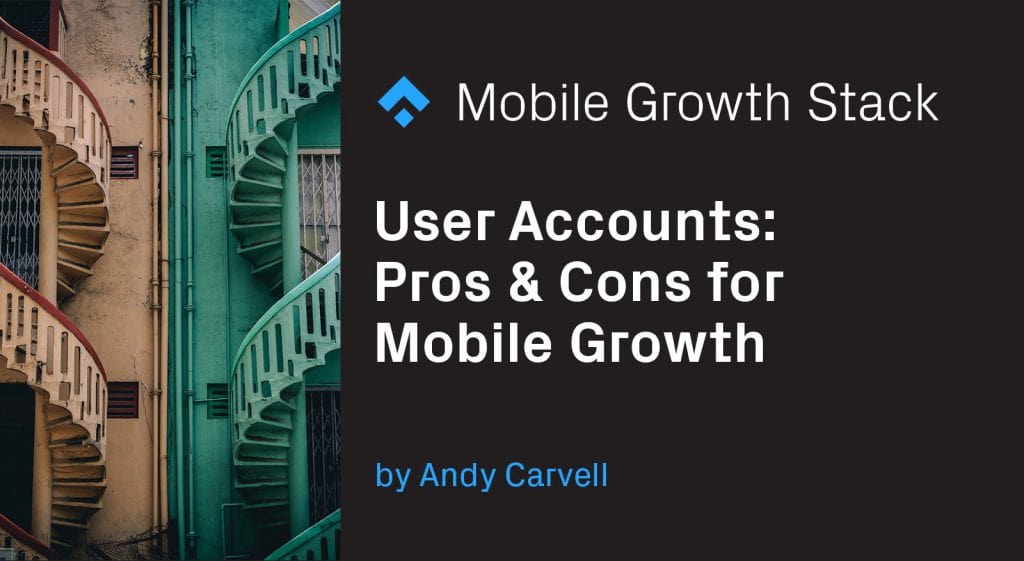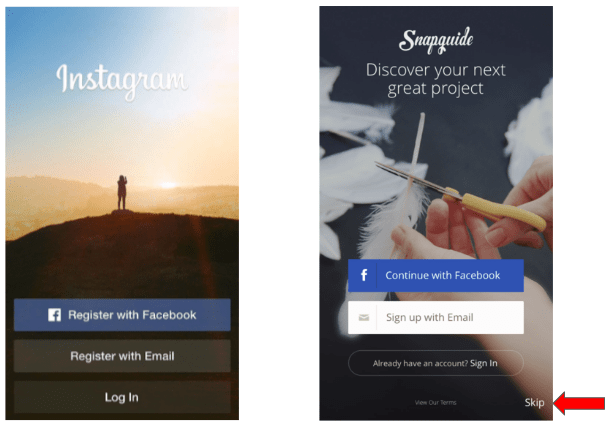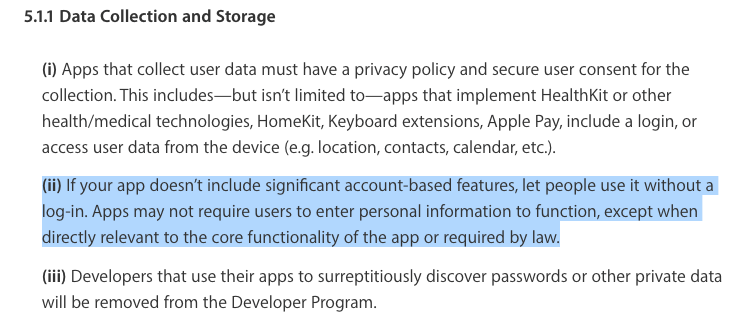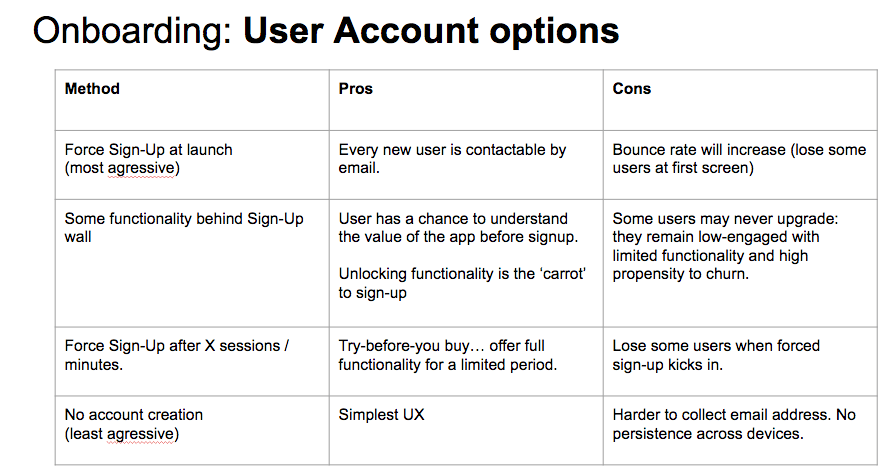
User accounts can be a fantastic way to build user loyalty and increase retention. However, they do not make sense in every scenario and come with significant overhead versus a simple ‘anonymous’ product experience.
In this post, I’ll outline the key benefits and costs of implementing a user account system in a mobile product and delve into some of the considerations involved in implementing user accounts.
The User Account Model Explained
A user account model is defined for the purposes of this article as a system that permits the user to register for an account or profile which uniquely identifies them in the product. Furthermore, such a system provides a way to sign in to a previously-created account (this is often done automatically in subsequent sessions after an account has been created).
Typically, in order to create an account, the user will be required to provide identification such as an email address, phone number, or a social ID. Many social networks have their own ID systems that make account authentication with websites and mobile apps quick and easy for the user. Examples include: Facebook Login, Sign In with Twitter, Google Sign-In, etc.
Once a user is associated with an account, it’s typical for apps to persist some information about the user in the cloud (i.e. not just locally stored within the app) and to personalize the experience within the app to some greater or lesser extent.
Benefits Of Implementing A User Account Model
There are numerous reasons why adding a User Account model can be great for engagement and retention metrics:
Permanence Across Devices, Multi-Device Support
Smartphones and tablets are lost, damaged and upgraded all the time. In the first two scenarios, without a cloud-based user account model, all of the user’s data (e.g. progress in a game, workout history in a fitness app, etc.) would be lost. In an upgrade scenario, the app would require some kind of data export and import feature in order to transfer any data across from the old to the new device: a process likely to be too confusing or time-consuming for many users.
For all but the most ardent of users, the situation described above is a recipe for high churn; users may decide that it’s simply not worth continuing to use the product.
If a user’s data is backed up to the cloud and a clean install of the app can be near-instantly restored to the state of the app on the user’s new device, continuity of experience can be achieved and a user has less reason to abandon the product.
This benefit is compounded in cases where the product exists on both Web and Native App platforms since users can enjoy continuity of their experience by signing into their account from desktop devices as well as mobiles. This may also apply to users who own and actively use more than one mobile device, such as a smartphone and a tablet.
Taking cross-device support one step further, Spotify makes great use of Apple’s Handoff feature to provide concurrency control and continuity of playback sessions between desktop and iOS devices: a user can begin streaming a music track on their desktop Mac, fire up the Spotify app on their iPhone and seamlessly continue listening, with the track picking up exactly where they left off.

(Above: an example of cross-device continuity in the Spotify App)
User Investment
Simply the act of creating an account requires an investment of effort — and often also the decision to share their private contact data such as email address. This account creation investment on the part of the user — even if no other benefits such as personalization are conferred — typically results in higher retention than users who do not create accounts. For more information on this phenomenon, I strongly recommend checking out Nir Eyal’s article on user investment, as well as his excellent Hook Model framework for understanding the psychology of habit and the design of habit-forming products.
This investment is increased if the user is given options to personalize or curate their profile and/or experience within the product through having an account. Giving the user a ‘digital locker’ to store — and revisit — whatever items, progress, history, bookmarked content, or other data they have amassed through usage of the product, increases the lock-in factor of the app and gives users more reasons to keep using it. Put another way, this investment of time and energy increases switching costs, since the user may have built up a collection of ‘stuff’ over months or even years, which would be emotionally difficult to abandon.
Enabling a cloud-hosted collection of ‘stuff’ within the product provides rich opportunities for re-engagement. SoundCloud, for example, discovered that the vast majority of listening on the platform is ‘repeat listening’ i.e. listening to tracks users had already heard, liked and saved to their collection. Armed with this insight, the team optimized the product to make saving tracks and playlists easier and surfacing the user’s personal collection more prominently within the app.
Collect Email/Phone Number
A valuable side-effect of account registration is the collection of contact details from the user, usually in the form of email or phone number. This provides a way to uniquely identify the user (and verify their identity in a confirmation step), but also — crucially — provides an additional communications channel and a valuable way to reach out to users with notifications, updates, newsletters, etc. When done well, such activity notifications and lifecycle marketing campaigns can significantly increase the retention and engagement of recipients.
Moreover, once a user has an account, it’s possible to request additional information from them to augment their profile. Giving the user the opportunity to connect additional social accounts or contribute more information about themselves increases opportunities for further personalization of the experience (or advertising), lower-friction sharing and invite flows, and possibly additional communication channels to reach the user through.
Downsides To Implementing A User Account Model
Increased Friction
As stated earlier, account creation requires some investment from the user. As such, there will always be some resistance or friction among some users who don’t wish to invest that effort. Such friction can be minimized through single-sign-on (SSO) flows such as Facebook Login, but can never be erased entirely. Friction will increase if additional permissions are requested from the user at sign-up. Forcing sign-up means accepting some users will churn or accept a poorer experience rather than create an account.
Additional Overhead
Cloud storage costs, implementation and testing of lost password retrieval mechanisms and additional security precautions required are just some of the reasons why implementing an account model should not always be an automatic default when creating a mobile product. Synchronization headaches across multiple devices, increased risk of fraud and additional data-protection scrutiny are also reasons to think twice before going down the user account path.
Decisions To Make When Considering User Accounts
When designing the product, the team should consider whether the benefits of implementing a user account system are likely to outweigh the — not insignificant — costs listed above.
Does An Account Model Make Sense?
For some simple apps, there is no obvious need for user accounts, though the team may still decide to implement them in order to gain user email addresses and to increase the user investment in the product. In these cases, the team will likely have to work harder to figure out how to ‘sell’ user accounts as a benefit to users. One way to do this is to place features behind the account ‘wall’, restricting access to certain functionality to those users who have an account.
For social platforms or multi-user games, the case for user accounts is far more straightforward; the creation of a unique identity on the platform is likely to be a requirement for all users.
When To Ask User To Sign Up?
If the decision to implement a user account model has been taken, the team needs to consider how aggressive to be with user accounts. The options range from a full account ‘wall’ (require sign-up in order to use the product) through making key features available only to signed-in users (typical case), or even just having accounts for users who want them, but making the full product functionality available to everyone.
In every case, it’s likely that conversion to sign-up can be improved through testing and iterating on copy and UX around sign-up; the way in which benefits of an account are explained to users, and the sign-up flow itself, will usually have a measurable effect on sign-up rates.

(Above: Instagram requires users to have an account to use the app at all, whereas Snapguide allows users to try out the app before registering)
If ‘guest mode’ is implemented, which allows users to experience the app without an account, the team should run experiments to find the right level of encouragement required — through in-app messages or other channels — to persuade users to sign up. The most aggressive approach would be to allow usage of the app only for a limited time before sign-up is required.
Given that apps lose 77% of their users in the first 3 days after install, it pays to figure out the optimum approach to keep users around the longest. While typically around 20% of users will bounce at a forced-signup wall upon the first launch of the app, the other 80% can at least be contacted via email, with some percentage of those responding to the email campaign and returning for another session. In some cases, however, allowing limited — or even full — access without an account may lead to higher average retention; the best way to be sure is to run a split test.
Observe Apple’s App Review Guidelines
If you have an iOS app, be aware that Apple strongly prefers that apps do not require accounts to function, unless strictly necessary…

(Above Apple App Review Guidelines. Src: https://developer.apple.com/app-store/review/guidelines/#legal)
Summary
User accounts can increase retention, help users transition between devices or platforms, and provide opportunities to increase engagement and investment from users by giving them a sense of identity and personal storage space. They also create opportunities to collect contact details and other information from users that can be used for personalization and lifecycle communications.
Users should first be convinced of the value of an account, which can be hard to achieve before they have used the product; providing ‘guest’ access to the app is one way to show users value before asking them to sign up. In any event, not all users will create an account; expect these users to churn. Engineering & maintenance costs increase when an account model is used, so the decision to implement one should not be made without due consideration.
Table of Contents













